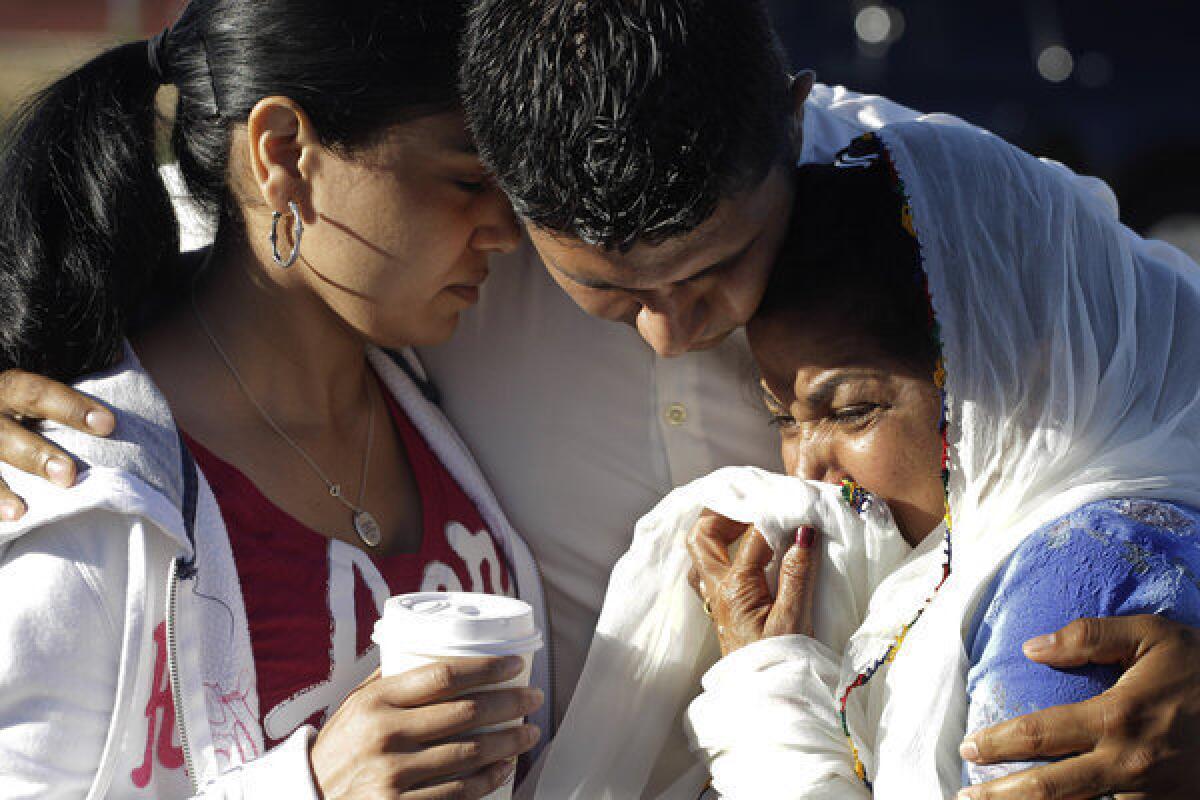Oak Creek: An act of home-grown terrorism

- Share via
It’s been a year since Wade Michael Page opened fire at a Sikh temple in Oak Creek, Wis. Since then, some basic facts about Page have come to light.
We now know that he was involved with white supremacy groups and that he was the founding member and vocalist for a neo-Nazi band. A former soldier, he had been heard to disparage Muslims, calling them “towel heads.” Even Page’s body served as a temple for his racist beliefs, bearing a tattoo of the number “14.” Among white supremacists, this stands for a 14-word credo coined by one of their heroes, David Lane: “We must secure the existence of our people and a future for white children.”
But the things I’d most like to know about Wade remain unknown. Why did he turn violent? And why did he target Sikhs? Did he confuse them with Muslims? Or was his hatred extended to anyone who wasn’t white?
OP-ED: ‘Sikhs are not Muslims’ sends a sinister message
In contrast, we know a great deal about what was unfolding at the Oak Creek Gurdwara on the morning of Aug. 5. The divan, the weekly religious ceremony, was about to begin. Musicians playing the harmonium and tabla would soon take the stage, along with the gyani, a priest adorned in long white robes. In the kitchen, women and children were preparing the langar, the holy food to be served at the end of the ceremony. Lentils, potatoes and cauliflower, cooked Indian style, are common fixtures at such meals. So too are salad and a mouth-watering sweet, just for good measure.
Had Page been hungry, he would have been welcomed and offered a hot meal. Perhaps he could have used one. He had recently stopped working and was behind on his rent. Instead, he opted for hate. By the time his murderous campaign had ended, seven people lay dead, six Sikh worshipers and Wade, who died by his own hand.
There was an immediate outpouring of emotion. Flames were lit and wreaths were laid. The expressions of support from random passersby and old friends alike were gratifying. A normally reticent co-worker stopped me in the hallway and said he was proud to be my colleague. Sikhism and its half a million U.S. followers were thrust onto the national stage.
WHO THEY WERE: Sikh temple shooting victims
Yet the tragedy also drove home our vulnerability and outsider status. President Obama was quick to visit Aurora, Colo., in the wake of the movie theater killings there, which occurred just weeks before the Wisconsin shootings. But he didn’t go to Oak Creek. Instead, in a clumsily worded speech just after the attack, he relegated Sikhs to part of the “broader American family.” At least he got our name right. Mitt Romney, then the GOP nominee for president, twice called us “sheiks.” The gaffe was so befuddling that I still don’t know what he was trying to say.
Like the politicians, the media quickly lost interest in what had happened. Just days after the attack, the story had largely disappeared from television news shows and the front pages of major newspapers.
Most disturbing, though, was the fact that Page’s crime was rarely given the proper label: It was an act of terrorism. A hate-filled man took up arms and assaulted America’s diversity. Wade attacked the very core of America’s promise, yet he was usually referred to as “the shooter.” Peaceful people who were simply exercising the freedom of religion promised in the Constitution were hunted down and killed by a white supremacist, yet it often wasn’t portrayed as a terrorist act.
OP-ED: My turban: Made in the USA
The terrorist threat posed by neo-Nazi groups in the United States is real and deadly. Yet even in the aftermath of Oak Creek, it is not taken all that seriously. A single congressional hearing was held in the weeks after the attack, but little came of it. Yes, the FBI will soon track hate crimes committed against Sikhs, just as it does for Muslims, Jews, atheists and others. But no comprehensive investigation of this home-grown threat has occurred.
On the other hand, the targeting of religious minorities continues. The New York Police Department continues to scrutinize Muslim student groups and mosques, even when it has no evidence of wrongdoing. And Sikh men are still subject to secondary searches or pat-downs every time they travel because turbans are considered a potential security threat under Transportation Security Administration guidelines. I often wonder what a young child thinks when he sees a Sikh traveler singled out and separated from his peers. It’s hard to break down stereotypes when those who look different are treated differently.
The other condition that made Oak Creek possible — the proliferation of guns — continues as well. There are nearly as many guns in America as there are people. Even the mentally ill and those with felony convictions, among the few people banned from purchasing guns, have little trouble obtaining them. A federal measure calling for universal background checks failed this year.
Gun proponents, meanwhile, stand resolute: The solution is to arm those in our schools so that violent intruders can be stopped. But where should the militarization end? Sikhs and Muslims shouldn’t have to pass by an armed officer every time they enter a house of worship. Nor should children going to school.
My 13-year-old cousin is the only Sikh boy in his school, and he is sometimes bullied by his peers. A few months ago, he asked me to talk to him about Oak Creek, and we discussed the tragic events of that August morning.
“Oak Creek won’t happen again, right?” he asked. I wish I could have said no.
Washington lawyer Arjun Sethi writes frequently on civil rights issues. Twitter: @arjunsethi81
More to Read
A cure for the common opinion
Get thought-provoking perspectives with our weekly newsletter.
You may occasionally receive promotional content from the Los Angeles Times.










